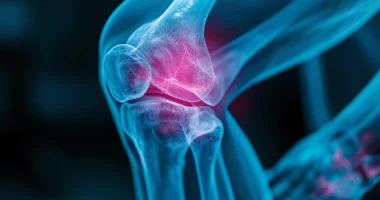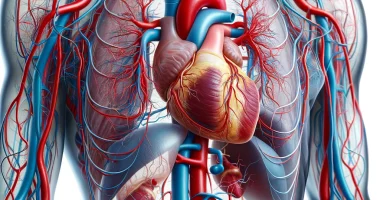Heart tumor
Definition
Cardiac tumors are histologically heterogeneous neoplasms that arise primarily from heart tissue or grow into it from other organs. Heart tumors, depending on their type, localization, and size, can cause shortness of breath, cough, tachycardia, arrhythmias, chest pain, heart failure, cardiac tamponade, and thromboembolism. The diagnosis of cardiac tumors takes into account the data from echocardiography, radiography, ventriculography, MRI and CT of the heart, ECG, and biopsy. If primary benign cardiac tumors are detected, their radical correction is performed; treatment of primary malignant and metastatic neoplasms is usually palliative (radiation therapy, chemotherapy).
General information
Cardiac tumors are a heterogeneous group of neoplasms growing from the tissues and membranes of the heart. Tumors can develop from any heart tissue and occur at any age. The neoplasms can sprout through the heart muscle and pericardium and affect the valves and septa of the heart. In the fetus, they can be detected by fetal echocardiography beginning at 16-20 weeks of intrauterine development. Primary cardiac tumors occur at an incidence of 0.001-0.2% in cardiology; secondary (metastatic) tumors are 25-30 times more common. All cardiac tumors carry a potential risk of deadly complications – heart failure, arrhythmias, pericarditis, cardiac tamponade, systemic embolism.
Classification
Tumors of the heart, representing independent diseases, are primary; tumors metastasizing through blood and lymphatic vessels or sprouting from adjacent organs are secondary. The causes of primary cardiac tumors are unknown. Secondary cardiac tumors are more often represented by metastases of breast, gastric, and lung cancer and less often by thyroid and kidney cancer.
According to the morphological principle, cardiac tumors are divided into benign (accounting for 75%) and malignant (accounting for 25%). By origin, malignant neoplasms can be both primary and metastatic secondary. Among benign tumors, cardiac myxomas (50-80%), teratomas, rhabdomyomas, fibromas, hemangiomas, lipomas, papillary fibroelastomas, pericardial cysts, paragangliomas, etc. are found. Malignant neoplasms include sarcomas, pericardial mesotheliomas, and lymphomas.
Primary benign cardiac tumors
Myxomas
Half of all primary cardiac tumors are myxomas. Sporadic cardiac myxomas are 2-4 times more common in women.
The predominant localization of myxomas is the left atrium (about 75%). Myxomas with a pedicle prolapse through the mitral valve, making it difficult for the left atrium to empty and the ventricle to fill during diastole. Macroscopically, myxomas may have a mucinous, solid, lobular, or friable structure. Unformed friable myxomas pose the greatest risk of systemic embolism.
Papillary fibroelastomas
Among primary cardiac tumors, benign papillary fibroelastomas are the second most frequent, predominantly affecting the aortic and mitral valves. Morphologically, they are vascular-free papillomas with actinia-like branches branching from a central core. They most often have a pedicle, but unlike myxomas, they do not cause valve dysfunction but increase the likelihood of embolism.
Rhabdomyomas
Rhabdomyomas account for 20% of all benign cardiac tumors and are the most frequent neoplasm in children. They are usually multiple, have intramural localization in the septum or wall of the left ventricle, and affect the heart’s conduction system. The course of rhabdomyoma may be accompanied by tachycardia, arrhythmias, and heart failure. These cardiac tumors are often associated with tuberous sclerosis, sebaceous gland adenomas, and benign renal neoplasms.
Fibromas
Connective tissue tumors of the heart are also mainly found in children. They can affect the valves and conduction system of the heart, cause mechanical obstruction, mimicking valve stenosis, clinical picture of heart failure, hypertrophic cardiomyopathy, and constrictive pericarditis. Cardiac fibromas may be part of the basal cell nevus syndrome (Gorlin syndrome).
Malignant heart tumors
Sarcomas are the most frequent primary malignant tumors of the heart. They occur mainly at a young age (mean age 40 years). Cardiac sarcomas can be represented by angiosarcomas (40%), undifferentiated sarcomas (25%), malignant fibrous histiocytomas (11-24%), leiomyosarcomas (8-9%), rhabdomyosarcomas, fibrosarcomas, liposarcomas, and osteosarcomas. Malignant cardiac tumors more often arise in the left atrium, leading to mitral obstruction, cardiac tamponade, heart failure, and metastasis to the lungs.
Pericardial mesotheliomas are relatively rare and occur predominantly in men. They usually metastasize to the pleura, spine, brain, and surrounding soft tissues.
Primary lymphomas are more likely to affect immunodeficient individuals (including HIV infection). These cardiac tumors tend to increase and are accompanied by heart failure, arrhythmias, tamponade, and superior vena cava syndrome.
Metastatic cardiac tumors most commonly affect the pericardium, less commonly the heart muscle, endocardium, and heart valves. Like primary heart tumors, they can cause dyspnea, acute pericarditis, cardiac tamponade, rhythm disturbances, atrioventricular block, and congestive heart failure. Lung cancer, breast cancer, kidney cancer, soft tissue sarcoma, leukemia, melanoma, lymphoma, and Kaposi’s sarcoma can metastasize to the heart.
Symptoms of heart tumors
The manifestations of cardiac tumors are determined by the type of neoplasm, its localization, size, and ability to decay. Non-cardiac tumors are manifested by fever, chills, weight loss, arthralgia, and skin rashes. When the tumor squeezes the heart chambers or coronary arteries, there is dyspnea and chest pain. Tumor growth or bleeding may lead to cardiac tamponade.
Cardiac tumors with intramyocardial growth (rhabdomyoma, fibromas) compressing or infiltrating the conduction system are accompanied by atrioventricular or intraventricular block and paroxysmal tachycardia (supraventricular or ventricular).
Intracavitary cardiac tumors mainly impair the function of the valves and obstruct the flow of blood from the heart chambers. They can cause mitral and tricuspid stenosis or insufficiency and heart failure. Symptoms of intracavitary cardiac tumors usually occur when the body’s position changes due to changes in hemodynamics and physical forces acting on the tumor.
Often, the first manifestation of cardiac tumors is thromboembolism to vessels in the systemic or pulmonary circulation. Right heart tumors can cause pulmonary embolism, pulmonary hypertension, and pulmonary heart disease; left heart tumors – transient cerebral ischemia and stroke, myocardial infarction, limb ischemia, etc. The occurrence of infarcts of internal organs in young people in the absence of congenital and acquired heart defects, atrial fibrillation, and infective endocarditis makes us think about the presence of a heart tumor.
Diagnosis
Due to the variability of clinical presentation and the multiplicity of morphologic forms of cardiac tumors, their diagnosis is a challenge.
ECG data in cardiac tumors are polymorphic and nonspecific: they may reflect signs of hypertrophy of heart chambers, conduction, and rhythm disturbances, myocardial ischemia, etc. Chest radiography most often reveals an increase in the size of the heart and signs of pulmonary hypertension. Cardiac ultrasound is a more sensitive method of diagnosing tumors: atrial tumors are better visualized by transesophageal echocardiography and ventricular tumors by transthoracic echocardiography.
In case of doubtful diagnostic results, cardiac MRI and CT, radioisotope scanning, cardiac cavity probing, and ventriculography are performed. To verify the histological structure of the heart tumor, its biopsy is performed during catheterization or diagnostic thoracotomy. A cytologic study of the fluid obtained during pericardial puncture can provide valuable diagnostic information in exudative pericarditis. Differential diagnosis of cardiac tumors is carried out with congenital heart defects, myocarditis, cardiomyopathies, pericarditis, and cardiac amyloidosis.
Treatment of heart tumors
Heart tumors are treated with surgery. Surgery for heart tumors may include removal of an intracavitary tumor, removal of a myocardial or pericardial tumor, pericardiectomy, or removal of a pericardial cyst. Radical surgery involves excision of the heart tumor with adjacent surrounding tissues, suturing, or repair of the defect. Benign heart tumors can be removed radically in most cases. In some cases, patients may require valve replacement or prosthetic valve replacement.
Removal of primary malignant heart tumors is ineffective. In this case, partial (palliative) removal of the tumor followed by radiation or chemotherapy is most often resorted to. Treatment is also palliative in secondary heart tumors.
All these treatment options are available in more than 550 hospitals worldwide (https://doctor.global/results/diseases/heart-tumor). For example, Heart tumor surgery can be done in these countries for following approximate prices:
Turkey $14.4 K in 26 clinics
China $20.3 K in 4 clinics
Germany $40.3 K in 26 clinics
Israel $51.7 K in 13 clinics
United States$69.6 K in 15 clinics.
Prognosis
Removal of single benign cardiac tumors is usually accompanied by good separate results – a 3-year survival rate is 95%. Thereafter, patients are monitored by a cardiologist and cardiac surgeon with annual echocardiography for timely detection of cardiac tumor recurrence. Multiple cardiac tumors reduce the survival rate over the next five years to 15%. In primary and metastatic cardiac tumors, the prognosis is very unfavorable; surgical treatment is ineffective, andchemotherapy and radiation therapy have little effect on the prognosis.


